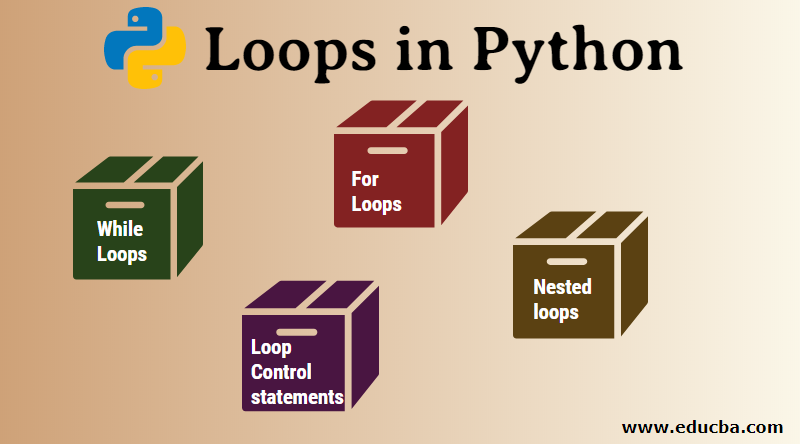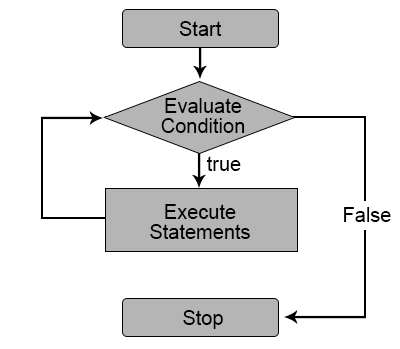what is used to define a block of code (in loops, if statements, functions, etc) in python

Introduction Loops in Python
A concept in Python programming package that allows repetition of sure steps, or printing or execution of the like set of steps repetitively, based on the keyword that facilitates such functionality being used, and that steps specified under the keyword automatically indent accordingly is known as loops in python. It is acting every bit a cake, with "while" continuing to execute until a certain specified status is met and "for" executing till the index variable in the specified range of values reaches its final value.
Looping is a common phenomenon in any programming language; From a python perspective, the powerful programming linguistic communication offers two broad categories of loops.
They are as below:
- While Loops
- For loops
While Loops
The common strategy backside while loops are they execute a set of statements until the given condition is satisfied. The next statement call happens at the case when the specified condition is satisfied. The use of indented lawmaking segments determines the segment or the body of the loop. Indentation starts the loop, and the line from which it starts to be unindented represents the cease of the mentioned loop. All non-zip values are interpreted as true here.
Flowchart

Example
Code
Code Snippet
n = ten sum = 0 i = one while i <= n: sum = sum + i i = i+1 print("The sum is", sum) While Loop Example
Python Program for Matching a String
Import Department
- import string
- import random
- import time
Variable section
endeavourNext = '' completed = False iterator = 0 Propable Characters to Compare
propableCharacters = string.ascii_lowercase + string.digits + string.ascii_uppercase + ' ., !?;:'
String to Exist Generated
t = input("Enter the expected string or word : ")
Generate the Initial Random String
endeavourThis = ''.join(random.choice(propableCharacters)
for i in range(len(t)))
Iterate While Completed Is Imitation
Increment the iterator
iterator += i endeavourThis = endeavourNext time.sleep(0.i) Driver Code
print("Target match found after " +
str(iterator) + " iterators")
For Loops
For traversing a sequential statement set, these loops are implied. The persistence of the loop is passed on awaiting the last item in the series is executed. While loop here to the content of the loop is separated from the residuum of the code by introducing the indentation. Every bit like while loop here to indentation plays an of import role in determining the body of the loop involved. Indentation starts the loop, and the line from which it starts to be unindented represents the end of the mentioned loop.
Flowchart

Example
for iterator_var in sequence:
statements(due south)
Code Snippet
For Loop Instance#ane
Python Program Using Turtle Graphing Technique
Import turtle
Role Definition
def border(obj1, panel_x, panel_y): obj1.penup() obj1.dwelling house() obj1.forward(panel_x / ii) obj1.right(ninety) obj1.forward(panel_y / 2) obj1.setheading(180) obj1.pencolor('red') obj1.pendown() obj1.pensize(10) for distance in (panel_x, panel_y, panel_x, panel_y): obj1.forward(distance) obj1.right(90) obj1.penup() obj1.domicile() def square(obj1, size, color): obj1.pencolor(color) obj1.pendown() for i in range(4): obj1.frontward(size) obj1.correct(90) def master(): panel = turtle.Screen() panel.championship('Square Demo') panel_x, panel_y = console.screensize() obj1 = turtle.Turtle() edge(obj1, panel_x, panel_y) colors = ['red', 'orange', 'yellow', 'green', 'blue', 'violet'] obj1.pensize(three) for i, color in enumerate(colors): square(obj1, (panel_y / 2) / 10 * (i+1), color) print('Striking whatsoever key to exit') dummy = input() Principal Program Phone call
if __name__ == '__main__':
primary()
For Loop Example#ii
Programme to concatenate ii LISTS into a dictionary.
Variable announcement
Key_elements=[] value_elements=[]
Count to be processed
var1=int(input("Count of elements for the dictionry:"))
impress (Key Elements)
for x in range(0,var1): chemical element=int(input("Element item entered" + str(x+ane) + ":")) Key_elements.append(element) Print (Value Elements)
for x in range(0,var1): chemical element=int(input("Chemical element item entered" + str(x+1) + ":")) value_elements.append(element) d=dict(naught(Key_elements,value_elements)) #Print Section print("The formulated dictionary is:") print(d) Nested loops
Nested looping is the process of looping one loop within the boundaries of others. So when the command flows from the outer loop to the inner loop, it returns back to the outer loop only when the inner loops are completed. Indentation is used to determine the body of the nested loops. Indentation starts the loop, and the line from which it starts to be unindented represents the terminate of the mentioned loop.
Example
Code:
for iterating_variable#i in sequence#1:
for iterating_variable#ii in sequence#2:
statements(s)
statements(southward)
while expression#1:
while expression#2:
argument(s)
statement(due south)
Nested Loop Case
Python Program for File Handling
import os def listfile(types): current_path,filename = bone.path.split(os.path.abspath(__file__)) Nested Looping Section in The Plan
Outer For Loop - - - - - - - - - -# for path,dir,file in bone.walk(current_path): file_name = str(file) Inner For Loop
for type in types: if file_name.endswith(type): impress(file_name) def deletefile(types): choice2 = input("Please enter the file to delete : ") os.remove(choice2) types = [".txt']",".srt]",".py]"] Header Area
print(" = = = = = = = = = = = = = = = = = = = = = " ) print(" $$$$$$$$$$$$$ FILE HANDELING $$$$$$$$$$$$ ") print(" = = = = = = = = = = = = = = = = = = = = = ") File Listing
File_list = listfile(types)
File Functioning
Print( Cheerio Bye )
exit
else:
Print( Invalid Pick )
go out
Python Loop Control Statements
Loops iterate above a block of code pending expression in testis fake, merely when there is an instance where we need to stop the loop without a check to the condition, that is where the loop control statements come up into play. The 3 major loop control statements in python are as below:
- Break: Terminates the loop and passes the control to the argument subsequently the loop. If a break is mentioned into a nested loop, then it is the innermost loop is where the break volition initially terminate.
- Go along: Skips the remaining sentences in the loop and checks the condition posted in the loop.
- Pass: It simply passes the execution when reaching a specific statement.
Loop Control Statements case
Python Program Using Loop Control Statements
var_a = 1 var_b = 2 while var_a < var_b: print(" Lawmaking enters while loop ") var_c = ["SUV","sedan","hatchback","Cease"] for iterator in var_c: if iterator == "SUV": impress("Hyundai creata") print("Mahindra bolero") print("---------------") if iterator == "sedan": Loop Command Argument: Laissez passer
laissez passer if iterator =="hatchback": print("Renault Kwid") print("suzuki alto") print("---------------") if iterator == "End": Loop Command Statement: Break
break
var_a = var_a+ane
Benefits of python Loops: The key advantages of loops are as beneath:
- Code reduction.
- Reduces code complexity.
- Brings in more stability into coding.
- Code redundancy is greatly resolved.
Conclusion – Loops in Python
The dominance exhibited past any programming language depends on the classified set of coding functionalities. In such instances, python programming'southward looping structure is largely stable and flexible to code which stands out to exist amidst the prior reasons which make this language dominate the market.
Recommended Articles
This has been a guide to Loops in Python. Here we talk over what the Loops in Python are, While loops, and much more with advisable sample code. Y'all can as well go through our other suggested articles to learn more –
- Python vs C++
- Python Collections
- Python File Operations
- Lexicon in Python
Source: https://www.educba.com/loops-in-python/
0 Response to "what is used to define a block of code (in loops, if statements, functions, etc) in python"
Post a Comment